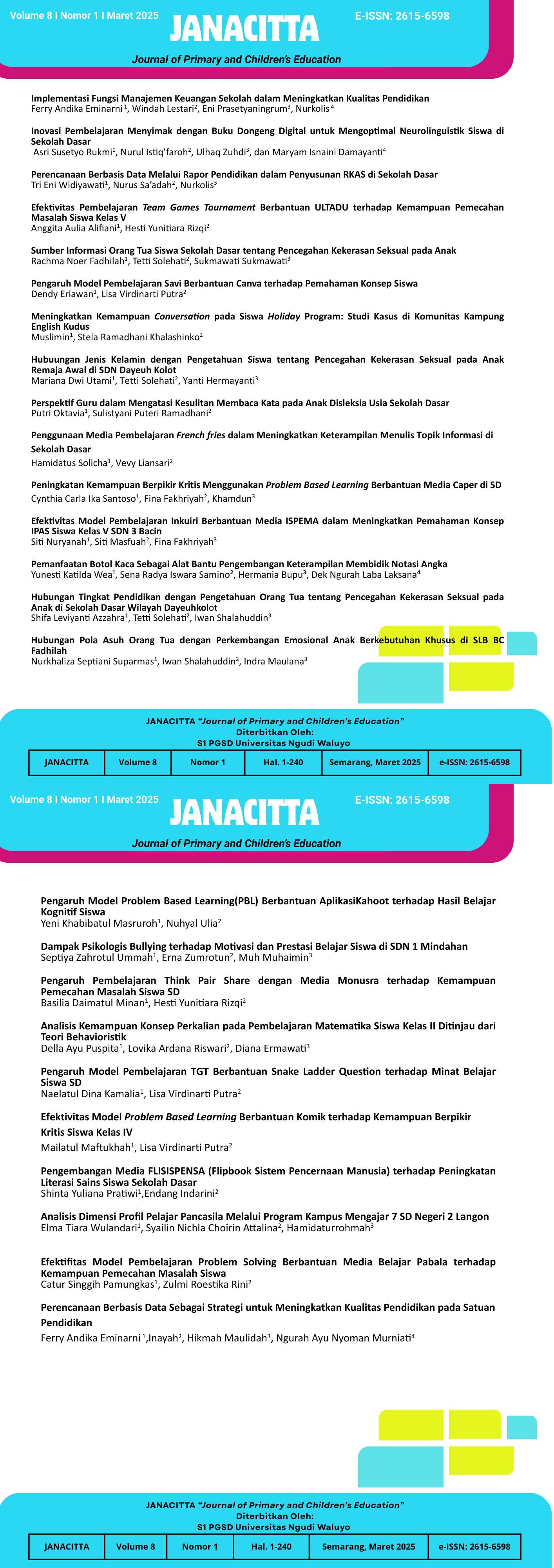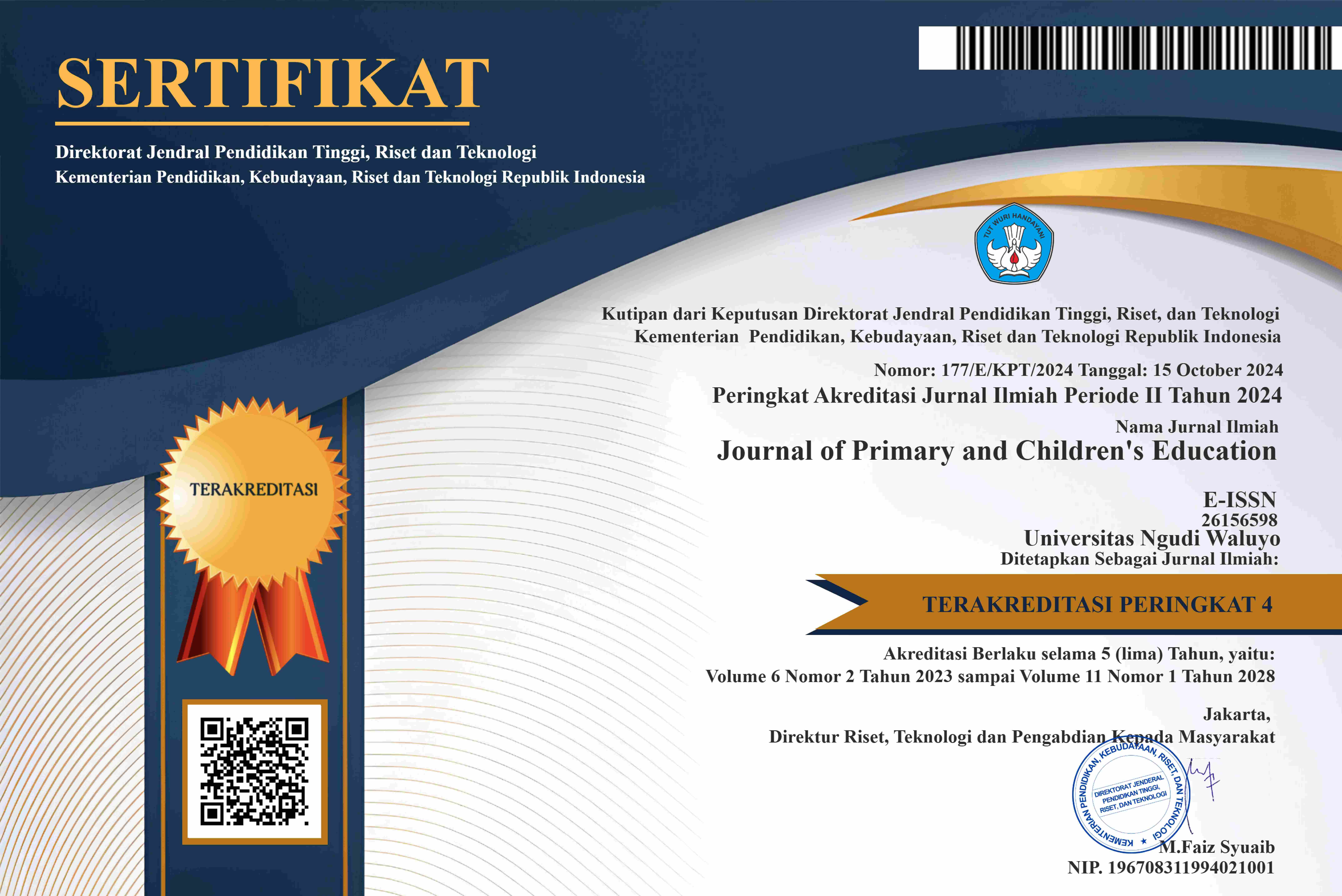Hubungan Jenis Kelamin dengan Pengetahuan Siswa tentang Pencegahan Kekerasan Seksual pada Anak Remaja Awal di SDN Dayeuh Kolot
DOI:
https://doi.org/10.35473/janacitta.v8i1.3780Abstract
Abstract
Cases of child sexual abuse (CSA) had reached an "Gawat Sexual Abuse" status. One of the causes of CSA was children's lack of knowledge about CSA prevention. Differences in gender roles and the strong influence of patriarchal ideology in society affected children's knowledge of CSA prevention. The risk of CSA increased when children entered early adolescence, as this period involved a phase of tansition. The aim of this study was to determine the relationship between gender and students' knowledge of CSA prevention in early adolescents. This research was a quantitative study with a correlational analytic approach. The study was conducted at SDN Dayeuh Kolot, Bandung Regency, from August to November 2024, involving 45 students from grades 4-6 of SDN Dayeuh Kolot. The sampling technique used was total sampling. The instrument used was a questionnaire developed by Solehati et al. (2022), which had been tested for validity and reliability. Data collection was carried out using a questionnaire distributed directly to students, consisting of demographic data and seven questions regarding knowledge of CSA prevention. Data analysis used univariate analysis in the form of frequency distribution and bivariate analysis using the Chi-Square test. The results showed that the majority of respondents were female (55.6%), and most respondents had good knowledge (57.8%). The bivariate analysis results showed a p-value of 0.095. From these findings, it was concluded that there was no relationship between gender and students' knowledge of CSA prevention in early adolescents at SDN Dayeuh Kolot.
Abstrak
Kasus kekerasan seksual pada anak (KSA) sudah berstatus “Gawat Sexual Abuse”. Salah satu penyebab terjadinya KSA adalah kurangnya pengetahuan anak tentang pencegahan KSA. Adanya perbedaan dalam peran gender dan ideologi patriarki yang masih kental di masyarakat mempengaruhi pengetahuan anak tentang pencegahan KSA. Risiko KSA meningkat ketika anak memasuki masa remaja awal karena pada usia tersebut terjadi fase transisi. Tujuan penelitian ini yaitu untuk mengetahui hubungan jenis kelamin dengan pengetahuan siswa tentang pencegahan kekerasan seksual pada anak remaja awal. Penelitian ini merupakan penelitian kuantitatif dengan desain cross sectional dan pendekatan analitik korelasional. Penelitian dilakukan di SDN Dayeuh Kolot, Kabupaten Bandung pada bulan Agustus-November 2024 dengan melibatkan 45 siswa kelas 4-6 SDN Dayeuh Kolot. Teknik pengambilan sampel menggunakan total sampling. Instrumen yang digunakan dalam penelitian ini adalah kuesioner terstandarisasi yang telah teruji validitas dan reliabilitasnya. Pengambilan data dilakukan menggunakan kuesioner yang diberikan secara langsung kepada siswa yang berisi data demografi dan 7 pertanyaan mengenai pengetahuan pencegahan KSA. Analisis data menggunakan univariat yaitu distribusi frekuensi dan bivariat yaitu Chi-Square. Hasil penelitian menunjukkan bahwa sebagian besar responden berjenis kelamin perempuan (55.6%), sebagian besar responden berpengetahuan baik (57.8%). Hasil analisis bivariat menunjukkan p-value sebesar 0.095. Dari temuan ini diambil kesimpulan bahwa tidak terdapat hubungan antara jenis kelamin dengan pengetahuan siswa tentang pencegahan KSA pada remaja awal di SDN Dayeuh Kolot.
References
Abeid, M., Muganyizi, P., Massawe, S., Mpembeni, R., Darj, E., & Axemo, P. (2015). Knowledge and Attitude Towards Rape and Child Sexual Abuse - A Community-Based Cross-Sectional Study in Rural Tanzania Health Behavior, Health Promotion and Society. BMC Public Health, 15(1). https://doi.org/10.1186/s12889-015-1757-7
Alifah, A. P., Apsari, N. C., & Taftazani, B. M. (2021). Faktor yang Mempengaruhi Remaja Hamil di Luar Nikah. Jurnal Penelitian dan Pengabdian Kepada Masyarakat (JPPM), 2(3), 529–537.
Alquaiz, A. M., Almuneef, M. A., & Minhas, H. R. (2012). Knowledge, Attitudes, and Resources of Sex Education Among Female Adolescents in Public and Private Schools in Central Saudi Arabia. Saudi Medical Journal, 33(9), 1001–1009.
AlRammah, A. A. A., Alqahtani, S. M., Babiker, A. G. E., Al-Saleh, S. S., Syed, W., Al-Mana, A. A. K., & Al-shammarie, H. H. (2018). Factors Associated with Perceptions of Child Sexual Abuse and Lack of Parental Knowledge: A Community-Based Cross-Sectional Study from the Eastern Province of Saudi Arabia. Annals of Saudi Medicine, 38(6), 391–398. https://doi.org/10.5144/0256-4947.2018.391
Amnestito, Z. A., Jati, S. N., & Vidyastuti. (2025). Perbedaan Perilaku Asertif pada Siswa Laki-laki dan Perempuan terhadap Kekerasan Seksual. Paedagogy : Jurnal Ilmu Pendidikan dan Psikologi, 4(4), 468–475. https://jurnalp4i.com/index.php/paedagogy
Arikunto, S. (2014). Prosedur Penelitian Suatu Pendekatan Praktik. Rineka Cipta.
BPS Kabupaten Bandung. (2023). Statistik Daerah Kabupaten Bandung 2023 .
Budiman, R. A. (2013). Kapita Selekta Kuesioner: Pengetahuan dan Sikap dalam Penelitian Kesehatan. Jakarta: Salemba Medika, P4-8.
Carvajal, M. J., Clauson, K. A., Gershman, J., & Polen, H. H. (2013). Associations of Gender and Age Groups on the Knowledge and Use of Drug Information Resources by American Pharmacists. Pharmacy Practice, 11(2), 71–80.
Dian, R. R. (2002). Hubungan Karakteristik, Status Sosial Ekonomi, Responden dan Sumber Informasi dengan Pengetahuan dan Sikap Mengenai HIV/AIDS pada Siswa SMU41 Jakarta Utara. Skripsi. Depok: Universitas Indonesia. Tidak dipublikasikan.
Djama, N. T., Lante, N., & Bansu, I. A. (2022). Buku Ajar Kesehatan Reproduksi Remaja. Eureka Media Aksara.
Himayanti, A. M., Prayito, M., Sulianto, J., & Wikyuni, S. (2023). Analisis Video Pembelajaran Simbol Pancasila melalui Aplikasi Canva Kelas 1 SDN Plamongansari 02. http://jurnal.unw.ac.id/index.php/janacitta
IJRS. (2022). Data dan Fakta Kekerasan Seksual di Indonesia 2021. Indonesia Judicial Research Society .
Khalifah, I. N., Demartoto, A., & Salimo, H. (2017). Health Belief Model and Labelling Theory in the Analysis of Preventive Behaviors to Address Biopsychosocial Impacts of Sexual Violence among Street Children in Yogyakarta. Journal of Maternal and Child Health, 02(04), 309–323. https://doi.org/10.26911/thejmch.2017.02.04.03
Kloppen, K., Haugland, S., Svedin, C. G., Maehle, M., & Breivik, K. (2016). Prevalence of Child Sexual Abuse in the Nordic Countries: A Literature Review. Journal of Child Sexual Abuse, 25(1), 37–55.
Maulida, D. H., & Ismaya, E. A. (2024). Analisis Hambatan Belajar Siswa dalam Mata Pelajaran IPS Kelas VI SD Negeri Perdopo 02 Gunungwungkal. JANACITTA : Journal of Primary and Children’s Education (Vol. 7). http://jurnal.unw.ac.id/index.php/janacitta
Murray, L. K., Nguyen, A., & Cohen, J. A. (2014). Child Sexual Abuse. Child and Adolescent Psychiatric Clinics, 23(2), 321–370.
Nlewem, C., & Amodu, O. K. (2017). Family Characteristics and Structure as Determinants of Sexual Abuse Among Female Secondary School Students in Nigeria: A Brief Report. Journal of Child Sexual Abuse, 26(4), 453–464. https://doi.org/10.1080/10538712.2017.1293202
Notoatmodjo, S. (2014). Ilmu Perilaku Kesehatan (2nd ed.). Rineka Cipta.
Noviana, I. (2015). Kekerasan Seksual terhadap Anak: Dampak dan Penanganannya. Sosio Informa, 1(1), 13–28.
Nurbaya, J, N., & Asrina, A. (2019). Gambaran Pengetahuan tentang Pencegahan Kekerasan Seksual pada Anak Remaja Awal di SD Islam Terpadu Nurul Fikri Makassar. Prosiding Seminar Nasional Sinergitas Multidisiplin Ilmu Pengetahuan dan Teknologi , 2, 65–70.
Octaviani, F., & Nurwati, N. (2021). Analisis Faktor dan Dampak Kekerasan Seksual pada Anak. Jurnal Ilmu Kesejahteraan Sosial HUMANITAS, 3(2), 56–60.
Ragita & Fardana N. (2021). Pengaruh Keterlibatan Ayah dalam Pengasuhan terhadap Kematangan Emosi pada Remaja. Buletin Riset Psikologi dan Kesehatan Mental (BRPKM), 1(1), 417–424.
Ravi, S., & Ahluwalia, R. (2017). What Explains Childhood Violence? Micro Correlates from VACS Surveys. Psychology, Health & Medicine, 17–30.
Rheingold, A. A., Zajac, K., Chapman, J. E., Patton, M., de Arellano, M., Saunders, B., & Kilpatrick, D. (2015). Child Sexual Abuse Prevention Training for Childcare Professionals: An Independent Multi-Site Randomized Controlled Trial of Stewards of Children. Prevention Science : The Official Journal of the Society for Prevention Research, 16(3), 374–385. https://doi.org/10.1007/s11121-014-0499-6
Ruspita, R., Susanti, K., & Rahmi, R. (2022). Kesehatan Reproduksi pada Remaja (1st ed., Vol. 1). Gosyen Publishing.
Sendratari, L. P. (2018). Membaca Kekerasan Seksual terhadap Anak Secara Kultural dan Struktural: Bahan Menabuh Genderang Perang. Jurnal Ilmiah Penelitian Pendidikan dan Sosiologi, 2(2), 1–15.
SIMFONI-PPA. (2024). Jumlah Kasus Kekerasan di Indonesia.
Solehati, T., Kosasih, C. E., Maryanti, I., & Juliansyah, E. (2019). Hubungan Sumber Informasi dengan Pengetahuan dan Sikap Siwa SD dalam Pencegahan Kekerasan Seksual. Jurnal Ilmiah Ilmu Kesehatan: Wawasan Kesehatan, 5(2). https://doi.org/10.33485/jiik-wk.v5i2.124
Solehati, T., Pramukti, I., Kosasih, C. E., Hermayanti, Y., & Mediani, H. S. (2022). Determinants of Sexual Abuse Prevention Knowledge among Children’s Schools in West Java Indonesia: A Cross-Sectional Study. Social Sciences, 11(8). https://doi.org/10.3390/socsci1108033
Sulistiani, S. L. (2016). Konsep Pendidikan Anak dalam Islam untuk Mencegah Kejahatan dan Penyimpangan Seksual. Ta’dib: Jurnal Pendidikan Islam., 5(1), 99–108.
Sumiyarrini, R., Susilowati, L., & Yati, D. (2022). Gambaran Persepsi dan Sikap Anak Usia Sekolah Dasar Tentang Kesehatan Seksual dan Pencegahan Kekerasan Seksual di Bantul, Yogyakarta. Jurnal Indonesia Sehat, 1(02), 93–101.
Svensson, J., Baer, N., & Silva, T. (2019). Adolescents’ Level of Knowledge of and Supportive Attitudes to Sexual Crime in the Swedish Context. Journal of Sexual Aggression, 25(2), 75–89. https://doi.org/10.1080/13552600.2018.1476600
Ulfaningrum, H., Fitryasari dan Eka Misbahatul Mar, R., (2021). Studi Literatur Determinan Perilaku Pencegahan Pelecehan Seksual pada Remaja (Vol. 2, Issue 1).
WHO. (2014). Health for the World’s Adolescents: A Second Chance in the Second Decade: Summary.
Wong, D. L., Hockenberry, M., Wilson, D., Winkelstein, M. L., & Schwartz, P. (2009). Buku Ajar Keperawatan Pediatrik (6th ed., Vol. 2). EGC.
Xie, Q. W., Qiao, D. P., & Wang, X. L. (2016). Parent-Involved Prevention of Child Sexual Abuse: A Qualitative Exploration of Parents’ Perceptions and Practices in Beijing. Journal of Child and Family Studies, 25(3), 999–1010. https://doi.org/10.1007/s10826-015-0277-5
Yamin, A., Ulpa, M., Kurniawan, K., & Mulya, A. P. (2024). Pengetahuan dan Sikap Remaja terhadap Kekerasan Seksual. Journal of Telenursing (JOTING), 6(2), 1763–1771. https://doi.org/10.31539/joting.v6i2.10621
Downloads
Published
How to Cite
Issue
Section
License
Copyright notice:
- Authors retain copyright and grant the journal right of first publication with the work simultaneously licensed under Creative Commons Attribution License that allows others to share the work with an acknowledgement of the work's authorship and initial publication in this journal.
- Authors are able to enter into separate, additional contractual arrangements for the non-exclusive distribution of the journal's published version of the work (e.g., post it to an institutional repository or publish it in a book), with an acknowledgement of its initial publication in this journal.
- Authors are permitted and encouraged to post their work online (e.g., in institutional repositories or on their website) prior to and during the submission process, as it can lead to productive exchanges, as well as earlier and greater citation of published work (The Effect of Open Access)







